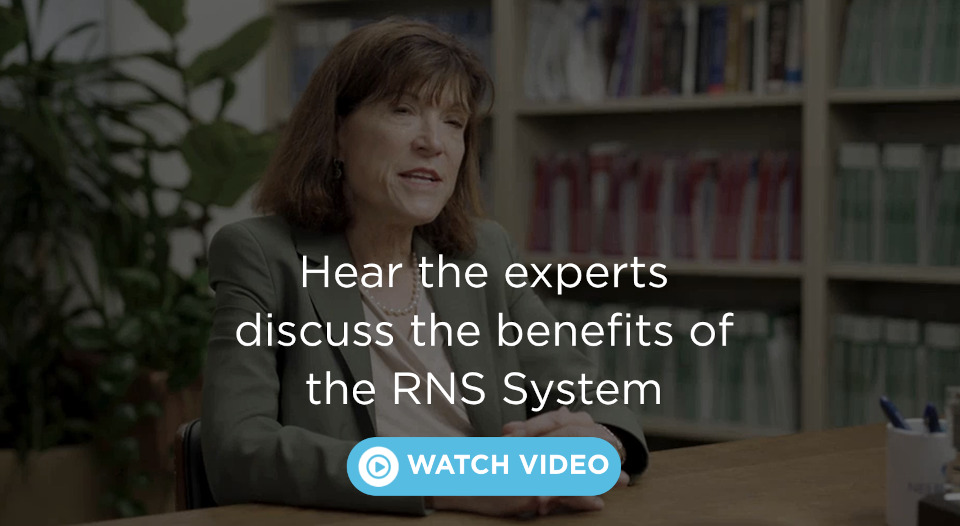The RNS System: An Established and Effective Epilepsy Treatment
July 11, 2025Reading Time: 4 minutes

Key Takeaways
If you’re looking for a focal epilepsy treatment that works when medications don’t, the RNS System may be the option you’ve been searching for. New strong clinical evidence shows that this neurostimulation device can significantly reduce seizures and even lead to periods of seizure freedom in people with refractory focal epilepsy.
What is the RNS System?
The RNS System is a responsive neurostimulator for people with drug-resistant focal epilepsy. The device monitors brain activity and delivers targeted stimulation to stop seizures before they begin. For those interested in finding out how to stop seizures at the source, learn how this neurostimulation seizure device can provide a medically proven option when other treatments fail.
Study results show long-lasting and rapid seizure reduction
A recent landmark study on drug-resistant focal epilepsy followed 324 adults for three years1. The study results showed many patients treated with the RNS System saw fewer seizures as early as the first six months. The findings include:
- Rapid seizure reduction: 62% median seizure reduction at 6 months1
- Long-lasting seizure reduction: 82% median seizure reduction at 3 years1
- Seizure Freedom: 42% of patients were seizure free for 6+ months1,6
These results offer strong clinical evidence that the RNS System is a highly effective focal epilepsy treatment for people who have not achieved seizure control with medication.
Epileptologists discuss the latest drug-resistant epilepsy research
“We have a responsibility to try to reduce the seizure burden for every patient we meet with epilepsy. Complacency is the enemy.”
– Martha Morrell, MD, NeuroPace Chief Medical Officer
How effective is the RNS System at reducing seizures?
One of the most important results from the study was how much the RNS System helped reduce seizures. After three years, people in the study had a median seizure reduction of 82%1. That means many people had far fewer seizures.
For example, for a person who had 10 seizures a month before getting the RNS System, an 82% reduction would mean they might go down to about 2 seizures a month. That’s a big change.
Interested in fewer seizures?
Can the RNS System stop seizures completely?
While the RNS System is not a cure for epilepsy, it has helped many patients experience meaningful seizure-free periods. The study showed that 42% of participants went at least six months without a seizure during the three-year study1,6. This level of control may allow people to return to work, travel more confidently, or live with greater independence.
If you’ve wondered how to stop seizures from happening, the RNS System may be the next step to explore.
“I tell my patients there’s a really good chance that you’re going to have at least six months of seizure freedom within that first three years, and sometimes longer, but it isn’t going to stop there,” Dr. Morrell says.
Does seizure control improve over time?
Yes. One of the most promising findings with the RNS System is that seizure reduction continues to improve over time. Many patients in the study saw fewer seizures within six months. But the biggest improvements were seen by year three, when median seizure reductions reached 82%, and many people were having long stretches without any seizures at all. Doctors can adjust the device over time to better match each patient’s needs, which contributes to continued improvement.
“We do know where to start, because we’re seeing that patients are getting better faster. But I can see, almost in real time, whether the trend is in the right direction, and if it isn’t in the right direction, re-evaluate. So, it really is very dynamic. It’s not a static therapy,” Dr. Morrell says.
The study will continue out to 5-year follow-ups, in addition to the 3-year data that’s been reviewed. That data is still being collected and examined.
RNS System vs. VNS Therapy: how do they compare?
When considering the RNS System vs. VNS Therapy, while both are seizure devices that provide neurostimulation for epilepsy, they work differently. The RNS System is responsive, delivering stimulation only when it detects abnormal activity, while the VNS therapy stimulates the vagus nerve at regular intervals. The RNS System does not have stimulation side effects such as hoarseness and coughing, – it works automatically to detect and stop seizures at the source. The RNS System has been shown to deliver faster and greater seizure reduction than other neuromodulation therapies for drug-resistant focal epilepsy.1-5
Speak with our Nurse Educator to learn more about epilepsy treatment options for drug-resistant focal epilepsy.
Wondering if the RNS System might be right for you?
If you’ve tried two or more epilepsy medications and still experience seizures, it’s time to consider advanced epilepsy treatments. The RNS System may be a fit if you have refractory focal epilepsy (also known as drug-resistant epilepsy) and are considering epilepsy surgery alternatives.
References
Note: Therapies were studied using different study designs. Caution must be exercised when comparing results.
- RNS System Post-approval Study Oral Presentation, American Academy of Neurology, April 2025, all outcomes are ITT, median seizure reduction is observed case data
- Morris et al, Neurology, 1999
- Kaufmann et al., Epilepsia, 2024
- VNS Prospective Trial (E01, E04 Pooled): https://www.accessdata.fda.gov/cdrh_docs/pdf/p970003.pdf
- Peltola et al., Neurology, 2023
- At some point during the study
*Every person’s seizures are different and individual results will vary



